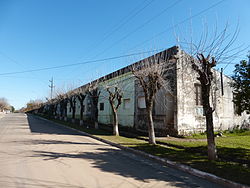Pueblo Liebig
- View a machine-translated version of the Spanish article.
- Machine translation, like DeepL or Google Translate, is a useful starting point for translations, but translators must revise errors as necessary and confirm that the translation is accurate, rather than simply copy-pasting machine-translated text into the English Wikipedia.
- Do not translate text that appears unreliable or low-quality. If possible, verify the text with references provided in the foreign-language article.
- You must provide copyright attribution in the edit summary accompanying your translation by providing an interlanguage link to the source of your translation. A model attribution edit summary is
Content in this edit is translated from the existing Spanish Wikipedia article at [[:es:Pueblo Liebig]]; see its history for attribution. - You may also add the template
{{Translated|es|Pueblo Liebig}}to the talk page. - For more guidance, see Wikipedia:Translation.
Pueblo Liebig | |
|---|---|
Municipality and village | |
 17 de Mayo street. | |
| Country |  Argentina Argentina |
| Province |  Entre Ríos Entre Ríos |
| Elevation | 112 ft (34 m) |
| Population (2010) | |
| • Total | 770[1] |
| Time zone | UTC−3 (ART) |
| Area code | 03447 |
Pueblo Liebig is a village and municipality in Entre Ríos Province in north-eastern Argentina.[2] This small town seduces tourists with its quiet pace, its recreational activities and a rich history.
History
Agriculture and cattle-raising have always dominated the Argentine plains. Leather and beef jerky obtained from rendering plants, or saladeros, were the leading income-producing products by the middle of the nineteenth century. Saladero Colon, property of Mr. Apolinario BenítezHistory goes that the foundation stone for progress in the area used to be a small saladero -a venue where meat is salted. Due to the various technological advances that reached the meat market in the late nineteenth century, English capital began to be invested and settled at this location to develop this kind of activities. That is how Liebig's Extract of Meat Company came here to stay.
References
32°09′11″S 58°11′28″W / 32.15306°S 58.19111°W / -32.15306; -58.19111
- v
- t
- e
Canción en homenaje a Liebig: https://www.youtube.com/watch?v=sCv-FTO2Fxc












